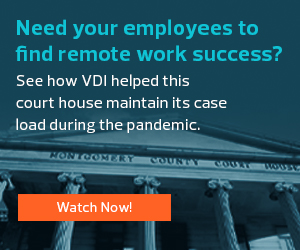One of the major trends state and local agencies can expect to see continuing after the pandemic is a renewed focus on Zoom as a mechanism to drive operational efficiencies. Zoom is one of the main companies that saw meteoric growth during the COVID-19 crisis, attributed to the platform’s ability to facilitate virtual face-to-face interactions among teammates regardless of location or tech savviness.
While state governments predominantly leverage Zoom Meetings to allow collaboration in real time, the platform is capable of so much more. In fact, Zoom Video Webinars, Zoom Rooms and Zoom Phone are also important features that can further facilitate an agency’s ability to keep its workforce connected and safe.
Even after the pandemic, these solutions will play a pivotal role in minimizing and eliminating the expenses of frequent travel while also providing a positive work environment for employees seeking flexible conditions. More important, these capabilities can expand the pool of potential candidates available for any open position, making hard-to-fill jobs in government easier to staff.
Zoom Has Become a Fundamental Collaboration Tool
When I tested Zoom, I focused on its security, ease of use and scalability as a platform that helps users hold the level of engagement needed to drive a productive meeting. Agencies across the government have used Zoom video to inform the public, as well as for internal communications and training. However, I noticed a simple and intuitive app powers the video-enabled interface and provides easy and simple access into conference rooms and other workspaces that are fundamental to collaboration among state and local officials and employees.
Additionally, since so many users have by now leveraged Zoom, either for personal or work purposes, it has become a foregone conclusion that it will still be around to facilitate remote work after the pandemic. A good example of this post-pandemic usefulness in state and local governments is Zoom’s ability to provide court systems with a secure and authorized platform for online communication and continuity of operations. And with features such as Zoom Meetings and Zoom Chat, agencies benefit from easy-start meetings for small teams with up to 1,000 users on screen.
MORE FROM STATETECH: Examine five common videoconferencing challenges and how to resolve them.
Agencies Boost Productivity Remotely or On-Premises with Zoom
According to Zoom, departments leveraging the platform experience an 85 percent increase in video usage, and employees feel more connected when using the platform. What I like specifically are the various built-in collaboration tools and features, which allow multiple participants to share their screens simultaneously and to co-annotate for a more interactive meeting.
From filters, reactions, polls, hand raising, music and video sharing, chat capabilities with groups, and a searchable history, I found Zoom makes all meetings more engaging and interactive. The integrated file sharing and the 10-year archive is also a game changer in being able to offer agencies an invaluable tool for improving citizen services long after these difficult times come to an end.
Zoom Offers Top Security Features for Government Consideration
Zoom boasts that it hosts over 200 million simultaneous meeting participants every minute of the day.
With so much use, security becomes an imperative feature to have, especially for state and local government meetings. The National Security Agency provides a detailed list of factors for agencies to consider when examining the IT security of a platform like Zoom. Here are some of the NSA’s questions on security.
- Is end-to-end encryption available, and does this use strong, well-known, testable encryption standards?
- Can users see and control who connects to collaboration sessions?
- Do users have the ability to securely delete data from the service and its repositories as needed?
- Has the service and/or app been reviewed or certified for use by a security-focused nationally recognized or government body?
For Zoom, the answer to all of those questions is yes.
From the start, Zoom was built around a secure meetings and collaboration platform, which has recently been enhanced with even more features.
The platform has undergone several security audits to uncover and close any existing vulnerabilities. Additionally, Zoom has received security accolades from recognized third-party experts for ensuring communications are established using 256-bit transport layer security encryption, and for making all shared content encrypted using AES-256 encryption. This protects data at rest and in transit.
Powerful controls also let presenters and officials monitor access to meetings and easily give trusted participants access to content. This access control lets presenters keep unauthorized viewers away from sensitive content and potential meeting disruptors at bay. The Zoom for Government platform conforms to most security requirements used by federal agencies, including being FIPS 104-2 certified.
As important to government users as security, Zoom’s assistive technology enables full accessibility for users with disabilities. From keyboard accessibility and screen reader capabilities to automatic transcription, Zoom is compliant with certain Section 508 standards of the Rehabilitation Act, as well as with EN 301 549 digital accessibility requirements.
Zoom
Compatibility: Apple macOS 10.10 or higher, Microsoft Windows 7 or higher
Resolution: HD video and audio
Room Connector: H.323/SIP Connector
Bandwidth Required: 2Mbps up and down for single screen












